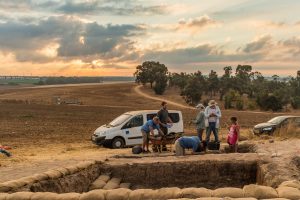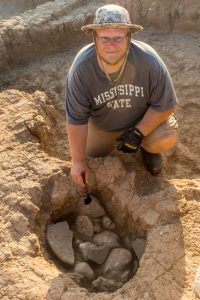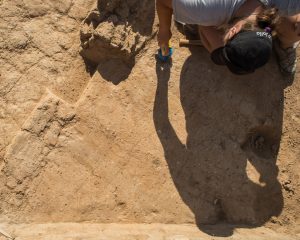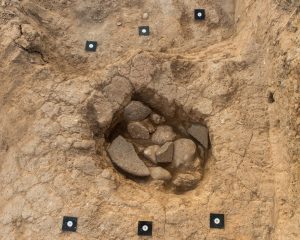
THE SUMMER GRIND IN ISRAEL
Kevin Williams, 2017 Harva L. Sheeler Excavation Fellowship Recipient
This summer I was able to travel to Israel and take part in the excavation of Khirbet Summeily, which is part of the Joint Archaeological Expedition to Tell el-Hesi. The Tell el-Hesi Archaeological Expedition is under the direction of Dr. Jimmy Hardin, Mississippi State University, and Dr. Jeff Blakely, University of Wisconsin. I took part in the excavation as a student from Mississippi State University.
This was the first archaeological excavation that I have ever been on! I grew up in rural Mississippi so getting dirty from head to toe was nothing new and my parents and grandparents might even say that I was an expert at it! My grandfather and my parents had gardens, so I was used to using gardening tools in soil. While the excavation tools we used are not quite the same as gardening tools, I really did not have any trouble getting adjusted to using them. I have to say that I grew quite fond of using the hand pick and the mattock. They were really a lot of fun to use! Dig it?
Soil is all the same anyway, right? The loess soil that we were excavating could be rather challenging at times. It was hard and at times it made me wonder if it had been compacted with sheepfoot rollers!
That is not to mention the ancient mudbricks that we encountered! They were harder than the in situ loess soil. At times we could see that we were in mudbrick because we could see the joints between them. At other
times we just “knew” we were in the midst of them. You could feel and hear the difference! Now, I may be making it sound as though it was really bad but it was not. Some of the fill sections were actually very
loose soil while we dug through them, but once the soil dried up …. So, soils are not all equal and they can also contain interesting inclusions … especially those at archaeological sites!
We also had to deal with stones while we were excavating. Some were just randomly part of the fill but some were there intentionally. A few of these formed a circle around the opening to a small pit in the square that I was working in, square 55. The previous excavations at the site had exposed these stones and the top of the pit.

One of the many beautiful sunrises that we were treated to on several mornings. The dig directors Dr. Jimmy Hardin and Dr. Jeff Blakely are in this shot as well!
I was charged with excavating the pit and in doing so I came across several stones beneath the surface. I then had to articulate between these stones. Almost all of the stones turned out to be pieces of a larger grind stone or a smaller grind stones. It was amazing to find all of these discarded grind stones! I could go on about so much more, but I will save that for another excavation!
I enjoyed having the opportunity to travel to and excavate in Israel! It was such a great and rewarding experience! All of it would not have been possible if it had not been for the Harva L. Sheeler Excavation Fellowship and ASOR! I can not thank you all enough!
Thank you so much!


